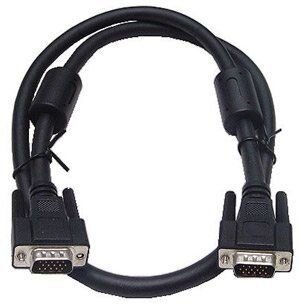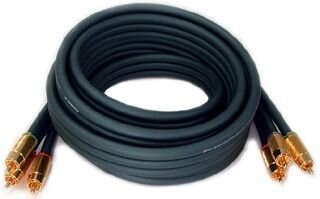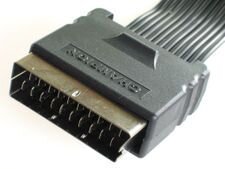I have my HD Reciever cables, but I also need some component cables for my DVD player. They seem so expensive everywhere I look and not very long cables either. Where online, or at retail stores would be the best place as far as pricing?
least expensive component cables?
- Thread starter HBKbiggestfan
- Start date
- Latest activity Latest activity:
- Replies 21
- Views 3K
You are using an out of date browser. It may not display this or other websites correctly.
You should upgrade or use an alternative browser.
You should upgrade or use an alternative browser.
- Status
- Please reply by conversation.
Well I for one would not select based on $$, high or low, rather shielding quality, performance, etc. AND in some cases length if you need them past 12'.
I shop at RamElectronics.net
http://www.ramelectronics.net/html/comp-video.html
Some guys shop at http://www.monoprice.com
I shop at RamElectronics.net
http://www.ramelectronics.net/html/comp-video.html
Some guys shop at http://www.monoprice.com
chadzx11 said:but many people use the term for the red/white/yellow RCA type A/V cables.
Those are composite cables.
Actually the red(right)/white(left)/yellow(video) RCA are usually called composite. The Red(Pr)/Blue(Pb)/Green (Y) are Component.
Gmta  ... Charper1 , WalMart has inexpensive 6' Phillips Brand Component Cables if you are in a hurry...
... Charper1 , WalMart has inexpensive 6' Phillips Brand Component Cables if you are in a hurry...
I bought a 25' component cable (RGB) at Fry's, and I think it was $25. I'm going by memory, so don't qoute me on that price.
Thanks everyone, lots of help. And yes I did mean COMPONENT as in the Red/Blue/Green. But again, thanks for the sites.
http://www.monoprice.com/products/p...04&p_id=2704&style=&seq=1&format=1#largeimage I didn't even know this existed. What do you guys think? Is it better quality for us who do NOT have DVI or HDMI?
Is there a HDMI-Component cable?
Is there a HDMI-Component cable?
Last edited:
Make sure the DVI-I works in your setup.
DVI-D - True Digital Video http://www.datapro.net/catalog/DVID.html
DVI-D cables are used for direct digital connections between source video (namely, video cards) and digital LCD (or rare CRT) monitors. This provides a faster, higher-quality image than with analog, due to the nature of the digital format. All video cards initially produce a digital video signal, which is converted into analog at the VGA output. The analog signal travels to the monitor and is re-converted back into a digital signal. DVI-D eliminates the analog conversion process and improves the connection between source and display.
DVI-I http://www.datapro.net/catalog/DVII.html
DVI-I cables are integrated cables which are capable of transmitting either a digital-to-digital signal or an analog-to-analog signal. This makes it a more versatile cable, being usable in either digital or analog situations.
Like any other format, DVI digital and analog formats are non-interchangeable. This means that a DVI-D cable will not work on an analog system, nor a DVI-A on a digital system. Make sure that you know what format each part of your equipment is before you purchase any DVI cables. Only equipment with a DVI port labeled 'DVI-I' will accept both a DVI-D and DVI-A source signal.
WHAT ARE SINGLE AND DUAL LINKS ?
Single: http://www.datapro.net/products/1141.html
Dual: http://www.datapro.net/products/1142.html
The Digital formats are available in DVI-D Single-Link and Dual-Link as well as DVI-I Single-Link and Dual-Link format connectors. These DVI cables send information using a digital information format called TMDS (transition minimized differential signaling). Single link cables use one TMDS 165Mhz transmitter, while dual links use two. The dual link DVI pins effectively double the power of transmission and provide an increase of speed and signal quality; i.e. a DVI single link 60-Hz LCD can display a resolution of 1920 x 1080, while a DVI dual link can display a resolution of 2048 x 1536.
HOW DO I KNOW WHICH CABLE TO USE?
Determining which type of DVI cable to use for your products is critical in getting the right cable the first time. Check both of the female DVI plugs to determine what signals they are compatible with.
* If one or both connections are DVI-D, you need a DVI-D cable.
* If one or both connections are DVI-A, you need a DVI-A cable.
* If one connection is DVI and the other is VGA, and the DVI is analog-compatible, you need a DVI to VGA cable or a DVI/VGA adaptor.
* If both connections are DVI-I, you may use any DVI cable, but a DVI-I cable is recommended.
* If one connection is analog and the other connection is digital, there is no way to connect them (regardless of connector type).
If you still have questions, look at: http://www.datapro.net/techinfo/dvi_cables.html
DVI-D - True Digital Video http://www.datapro.net/catalog/DVID.html
DVI-D cables are used for direct digital connections between source video (namely, video cards) and digital LCD (or rare CRT) monitors. This provides a faster, higher-quality image than with analog, due to the nature of the digital format. All video cards initially produce a digital video signal, which is converted into analog at the VGA output. The analog signal travels to the monitor and is re-converted back into a digital signal. DVI-D eliminates the analog conversion process and improves the connection between source and display.
DVI-I http://www.datapro.net/catalog/DVII.html
DVI-I cables are integrated cables which are capable of transmitting either a digital-to-digital signal or an analog-to-analog signal. This makes it a more versatile cable, being usable in either digital or analog situations.
Like any other format, DVI digital and analog formats are non-interchangeable. This means that a DVI-D cable will not work on an analog system, nor a DVI-A on a digital system. Make sure that you know what format each part of your equipment is before you purchase any DVI cables. Only equipment with a DVI port labeled 'DVI-I' will accept both a DVI-D and DVI-A source signal.
WHAT ARE SINGLE AND DUAL LINKS ?
Single: http://www.datapro.net/products/1141.html
Dual: http://www.datapro.net/products/1142.html
The Digital formats are available in DVI-D Single-Link and Dual-Link as well as DVI-I Single-Link and Dual-Link format connectors. These DVI cables send information using a digital information format called TMDS (transition minimized differential signaling). Single link cables use one TMDS 165Mhz transmitter, while dual links use two. The dual link DVI pins effectively double the power of transmission and provide an increase of speed and signal quality; i.e. a DVI single link 60-Hz LCD can display a resolution of 1920 x 1080, while a DVI dual link can display a resolution of 2048 x 1536.
HOW DO I KNOW WHICH CABLE TO USE?
Determining which type of DVI cable to use for your products is critical in getting the right cable the first time. Check both of the female DVI plugs to determine what signals they are compatible with.
* If one or both connections are DVI-D, you need a DVI-D cable.
* If one or both connections are DVI-A, you need a DVI-A cable.
* If one connection is DVI and the other is VGA, and the DVI is analog-compatible, you need a DVI to VGA cable or a DVI/VGA adaptor.
* If both connections are DVI-I, you may use any DVI cable, but a DVI-I cable is recommended.
* If one connection is analog and the other connection is digital, there is no way to connect them (regardless of connector type).
If you still have questions, look at: http://www.datapro.net/techinfo/dvi_cables.html
Well? Please note the pics attached.
1. RGB - BNC
2. RGB - RCA (RCA is a connection "tip" not a cable type)
3. RGB - VGA
4. Component - RCA
5. SCART
Analog component video
Analog video signals (also called components) must provide red, green and blue signals to create a television image. The simplest type, RGB, consists of the three discrete red, green and blue signals sent down three coaxial cables. There are a number of variant schemes which vary according to how synchronization is handled. If a synchronisation signal sent on the green channel, it is called sync-on-green. Some schemes use a separate sync channel, for instance the European SCART connection scheme in which the video signal occupies four (R,G,B + sync) of the 21 pins in the interface. SVGA, another RGB scheme, is used worldwide for computer monitors (this is somethimes known as RGBHV, as the horizontal and vertical synchronisation pulses are sent on separate lines).
An alternative type of componentization does not use R,G,B components but rather a colorless component, termed luminance combined with one or more color-carrying components, termed chrominance, that give only color information. Mulitiple chrominance channels allow for more precision and speed in mapping the RGB colour space. This componentization scheme is a linear transformation of the sRGB color space. This type of signal is usually what is intended when people talk of component video today. Variants of this format include YUV, YCbCr, YPbPr and YIQ commonly used in video systems.
In component video systems, additional synchronization signals may need to be sent along with the images. The synchronization signals are commonly transmitted on one or two separate wires, or embedded in the blanking period of one or all of the components. In computing, the common standard is for two extra wires to carry the horizontal and vertical components ('separate syncs'), whereas in video applications it is more usual to embed the sync signal in the Y component ('sync on luminance').
S-Video is another type of component video signal, because the luminance and chrominance signals are transmitted on separate wires. This connection type, however, cannot produce high definition or digital-quality pictures (pictures with more than 480 interlaced lines of video for NTSC or more than 576 lines of interlaced video for PAL). Component video is capable of producing signals such as 480p, 720p, 1080i and 1080p, but digital connections such as DVI (video only) and HDMI (which can also include up to 8 channels of audio) give better results at the higher resolutions (up to 1080p).
Digital component video
The digital component video is sometimes refered to as 4:2:2. This means that for every 4 pixels of luminance (Y) information, only 2 pixels of Pb (Blue Difference), and 2 pixels of Pr (Red difference) are encoded. This is the scheme used for the DVD format. The numbers also represent the relative number of bits (but not the actual number) used to carry the three pieces of information at each pixel. The colour information is spread across the pixels it represents.
Another scheme encountered will be 4:1:1. This is the scheme used on the NTSC version of the DV (and hence miniDV) tape formats for camcorder use. In this case for every 4 pixels of luminance, only 1 pixel of the Pb and Pr difference information is encoded for each line.
To provide apparent confusion, the PAL version of the DV and miniDV tape format use 4:2:0 which would appear to suggest the absence of the Pr signal altogether. In fact, the system takes advantage of features of the PAL colour system, and encodes 2 pixels of Pb colour difference for every 4 luminence pixels on odd lines only. On even lines, 2 pixels of Pr colour difference are encoded for every 4 luminance pixels. In each case the missing information is recovered from the previous line (and is thus closer to the French SECAM system than PAL). This doubles the horizontal resolution but halves the vertical resolution. This is acceptable, because the PAL analogue colour system does in fact have half the vertical resolution of the NTSC system.
1. RGB - BNC
2. RGB - RCA (RCA is a connection "tip" not a cable type)
3. RGB - VGA
4. Component - RCA
5. SCART
Analog component video
Analog video signals (also called components) must provide red, green and blue signals to create a television image. The simplest type, RGB, consists of the three discrete red, green and blue signals sent down three coaxial cables. There are a number of variant schemes which vary according to how synchronization is handled. If a synchronisation signal sent on the green channel, it is called sync-on-green. Some schemes use a separate sync channel, for instance the European SCART connection scheme in which the video signal occupies four (R,G,B + sync) of the 21 pins in the interface. SVGA, another RGB scheme, is used worldwide for computer monitors (this is somethimes known as RGBHV, as the horizontal and vertical synchronisation pulses are sent on separate lines).
An alternative type of componentization does not use R,G,B components but rather a colorless component, termed luminance combined with one or more color-carrying components, termed chrominance, that give only color information. Mulitiple chrominance channels allow for more precision and speed in mapping the RGB colour space. This componentization scheme is a linear transformation of the sRGB color space. This type of signal is usually what is intended when people talk of component video today. Variants of this format include YUV, YCbCr, YPbPr and YIQ commonly used in video systems.
In component video systems, additional synchronization signals may need to be sent along with the images. The synchronization signals are commonly transmitted on one or two separate wires, or embedded in the blanking period of one or all of the components. In computing, the common standard is for two extra wires to carry the horizontal and vertical components ('separate syncs'), whereas in video applications it is more usual to embed the sync signal in the Y component ('sync on luminance').
S-Video is another type of component video signal, because the luminance and chrominance signals are transmitted on separate wires. This connection type, however, cannot produce high definition or digital-quality pictures (pictures with more than 480 interlaced lines of video for NTSC or more than 576 lines of interlaced video for PAL). Component video is capable of producing signals such as 480p, 720p, 1080i and 1080p, but digital connections such as DVI (video only) and HDMI (which can also include up to 8 channels of audio) give better results at the higher resolutions (up to 1080p).
Digital component video
The digital component video is sometimes refered to as 4:2:2. This means that for every 4 pixels of luminance (Y) information, only 2 pixels of Pb (Blue Difference), and 2 pixels of Pr (Red difference) are encoded. This is the scheme used for the DVD format. The numbers also represent the relative number of bits (but not the actual number) used to carry the three pieces of information at each pixel. The colour information is spread across the pixels it represents.
Another scheme encountered will be 4:1:1. This is the scheme used on the NTSC version of the DV (and hence miniDV) tape formats for camcorder use. In this case for every 4 pixels of luminance, only 1 pixel of the Pb and Pr difference information is encoded for each line.
To provide apparent confusion, the PAL version of the DV and miniDV tape format use 4:2:0 which would appear to suggest the absence of the Pr signal altogether. In fact, the system takes advantage of features of the PAL colour system, and encodes 2 pixels of Pb colour difference for every 4 luminence pixels on odd lines only. On even lines, 2 pixels of Pr colour difference are encoded for every 4 luminance pixels. In each case the missing information is recovered from the previous line (and is thus closer to the French SECAM system than PAL). This doubles the horizontal resolution but halves the vertical resolution. This is acceptable, because the PAL analogue colour system does in fact have half the vertical resolution of the NTSC system.
Attachments
Last edited:
Actually it doesnt really "exist" yet considering no STB unit outputs it and no broadcaster broadcasts it. TV's may upconvert to it internally. I suppose if you have an HTPC then you may want a cable that can do 1080p.HBKbiggestfan said:Honestly I did't know 1080p even existed. My TVs only HD is 1080i. Does anyone here have 1080p?
As for cables go here, you will find they have various grades of component cables
http://www.cablestogo.com/product_list.asp?ListAbsolutePage=5&list_PagingMove=First&row=51&cat_id=2010&dept_id=&dept_name=
Last edited:
Well I got some really good RCA components from Wal-Mart. They have 24kt. Gold and are protected for best continuous picture. 
- Status
- Please reply by conversation.
Similar threads
- Replies
- 1
- Views
- 454
- Replies
- 4
- Views
- 2K
- Replies
- 8
- Views
- 2K
- Replies
- 9
- Views
- 3K






